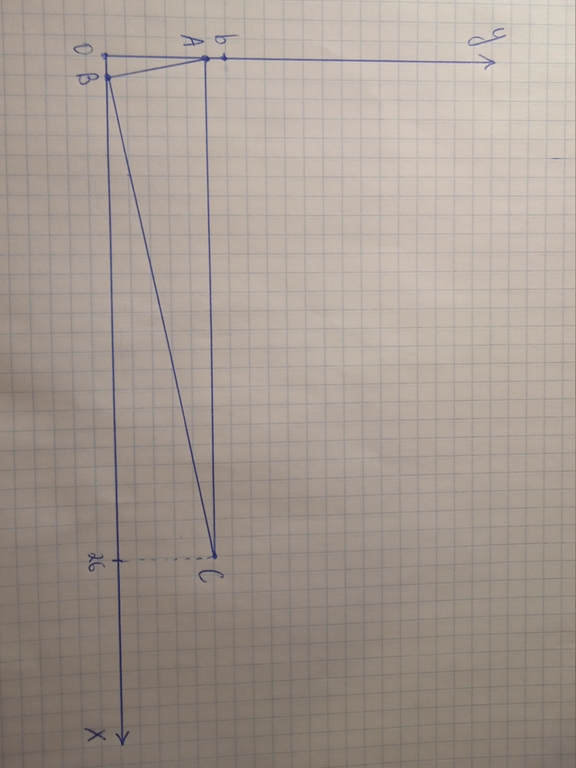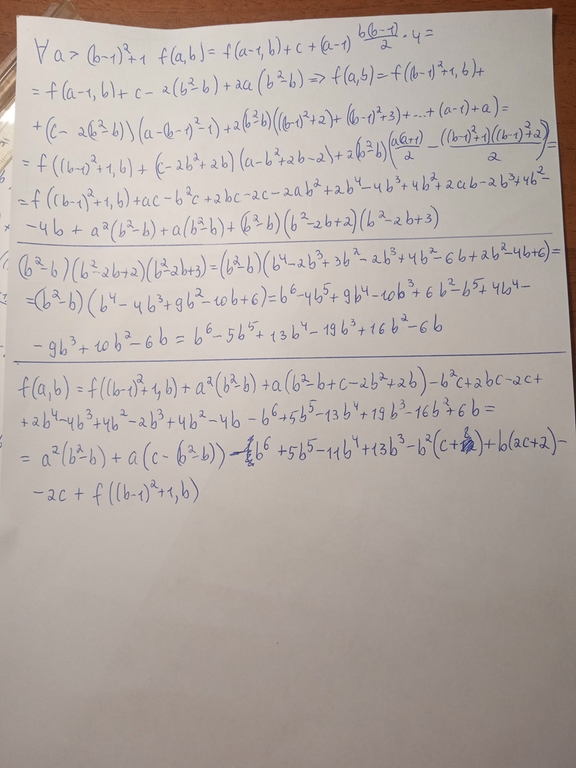Hello, Codeforces. Recently I invented a problem. Consider a set of points (x, y) with integer coordinates, 0 <= x < a и 0 <= y < b. We want to know the number of acute triangles with vertices at given points.
Trying to interpolate
We can write function f(a, b) which finds the answer and works in (ab) ^ 3. I suggested that it is a polynomial of two variables with degree <= 6. I tried to interpolate it using this theorem. But my code finds non-zero coefficients with monoms with degrees > 6, so my hypothesis was not confirmed. I also failed with right triangles.
This code finds a coefficient with a ^ (C1 - 1) * b ^ (C2 - 1)
What I would like to know:
- can this problem be solved faster than O(stupid(a, b))
- can this problem be solved in O(1)
- maybe, someone knows problems with difficult to find formulas and this method can help to find them?
UPD: Found formula for the number of right triangles with b = 2: f(a, 2) = 2 * a ^ 2 - 4, a > 1.
UPD2: Many thanks to bronze_coder for finding O(1) solution for constant b: OEIS A189814.
Interpolation should use ai > b ^ 2.
UPD3: Finally wrote a O((ab) ^ 2) solution.
Now I can interpolate using bigger values of a and b.
But it is quite strange for me that the number of right triangles is directly proportional to (ab) ^ 2 instead of (ab) ^ 3. Now I will try to understand why the formula doesn't work with ai <= b ^ 2.
UPD4: Code that finds a formula for f(a, b) for a > b ^ 2 and works in O(b ^ 6):
I used OEIS to find a regularity between the coefficients of P, but i didn't find anything :( except x2 = b * (b - 1), but it was obvious.
UPD5:
Finally found a formula and solution in O(min(a, b) ^ 6)
If a < b, let's swap them. Now we need to solve it in O(b ^ 6). If a <= (b - 1) ^ 2 + 1, we can run solution in O((ab) ^ 3) = O(b ^ 6). Now we need to solve it for a > (b - 1) ^ 2 + 1.
Definitions
Consider all right triangles and divide them into 3 types:
triangles without any vertices on the line
x = a - 1triangles with some vertices on the line
x = a - 1and with two sides which are parallel to the x-axis or y-axisother triangles
Let C(a) be the number of third type triangles (some function).
The number of second type triangles is (a - 1) * b * (b - 1) / 2 * 4:
By definition, for every vertex (x, y) of first type triangles, 0 <= x < a - 1 and 0 <= y < b, then the number of the triangles is f(a - 1, b), by definition of f.
Well, f(a, b) = f(a - 1, b) + (a - 1) * b * (b - 1) / 2 * 4 + C(a)
Let's prove that C(a) for every a > (b - 1) ^ 2 + 1 has same values.
C(a) is a constant. Let c be this constant.
Well, f(a, b) = f(a - 1, b) + (a - 1) * b * (b - 1) / 2 * 4 + c. After some transforms, we get a formula for f(a, b) using f((b - 1) ^ 2 + 1, b).
Unfortunately, the value of c is different for different values of b and I could not find a regularity between them. Interpolation and OEIS did not help me. There are some things I should do:
- Express
cthroughb, after allcdepends onbonly - Solve the problem for
a <= (b - 1) ^ 2faster - Solve the problem for acute triangles.
It will be hard.
UPD6: We can speed up the solution to O(b^5) using this idea













Auto comment: topic has been translated by polosatic (original revision, translated revision, compare)
The right triangle problem is OEIS A077435
EDIT: OEIS A189814 gives the answer for rectangles.
Thank you! I was quite sure that problem with right triangles can be solved in
O(a * b)But unfortunately, f(n, n) also is not a polynomial of one variable.OMG! I used too small
aifor interpolation with constant b, so it didn't work. After usingai >= b ^ 2everything works!Very nice
A not-implemented solution: let the triangle be tree vectors $$$a,b,c$$$.brute force $$$b-a$$$, and you will get $$$\dfrac{c-a}{|c-a|}$$$(which is rotate it for 90 deg(you can asumme ccw or cw))(In program, you can do it by a ). then you can brute force $$$c-a$$$ by $$$O(a + b)$$$. Then the problem is:
which is trival.
If I understand you correctly, I have already implemented this solution in UPD3 of this blog
No. This solution is $$$O(ab(a+b))$$$.
UPD3 is
Brute force b-a and c-a, find if b-a ⊥ c-a and find how many triangles with vector b-a and c-a.But we can just brute force $$$|c-a|$$$(The length of c-a). the angle of $$$c-a$$$ is found by rotate $$$b-a$$$.
Wow! Good idea! Thank you.
why $$$O(a^2b^2(a+b))$$$ is $$$O(b^5)$$$? may $$$a \gg b^2$$$.
The solution in UPD5 needs to calculate
f((b - 1) ^ 2 + 1, b)andf((b - 1) ^ 2 + 2, b)to calculatef(a, b), it works inO(b ^ 6), but can be optimized toO(b ^ 5)using your method.